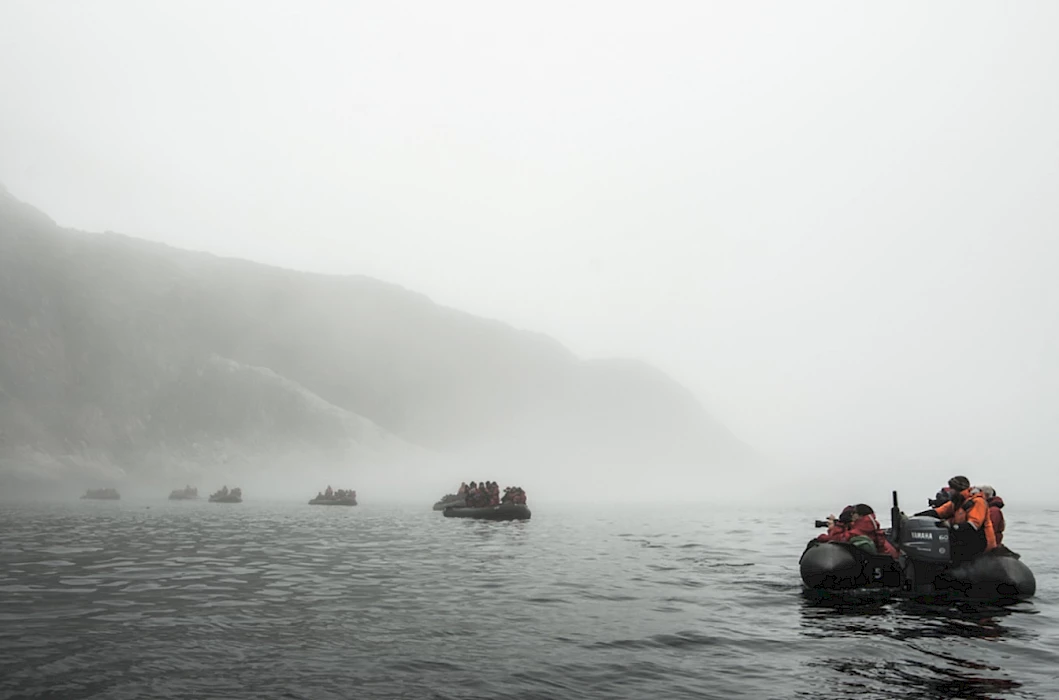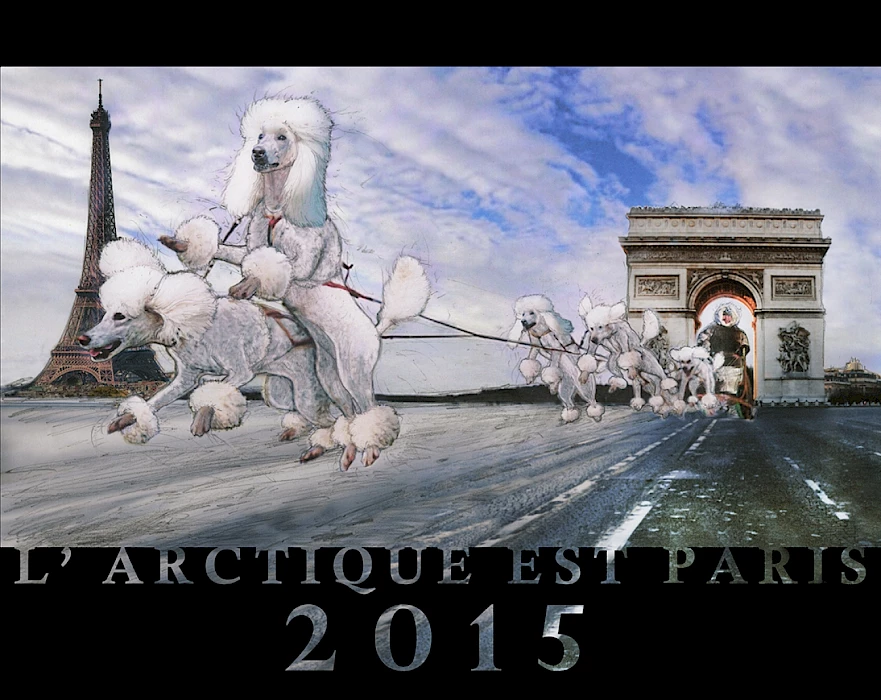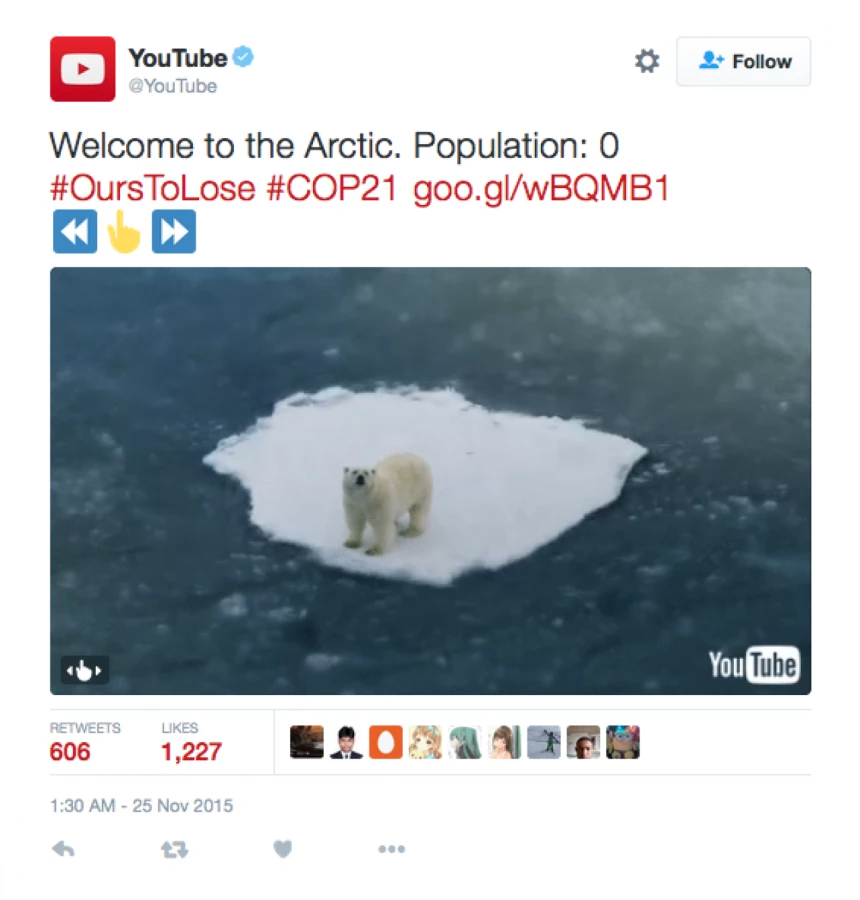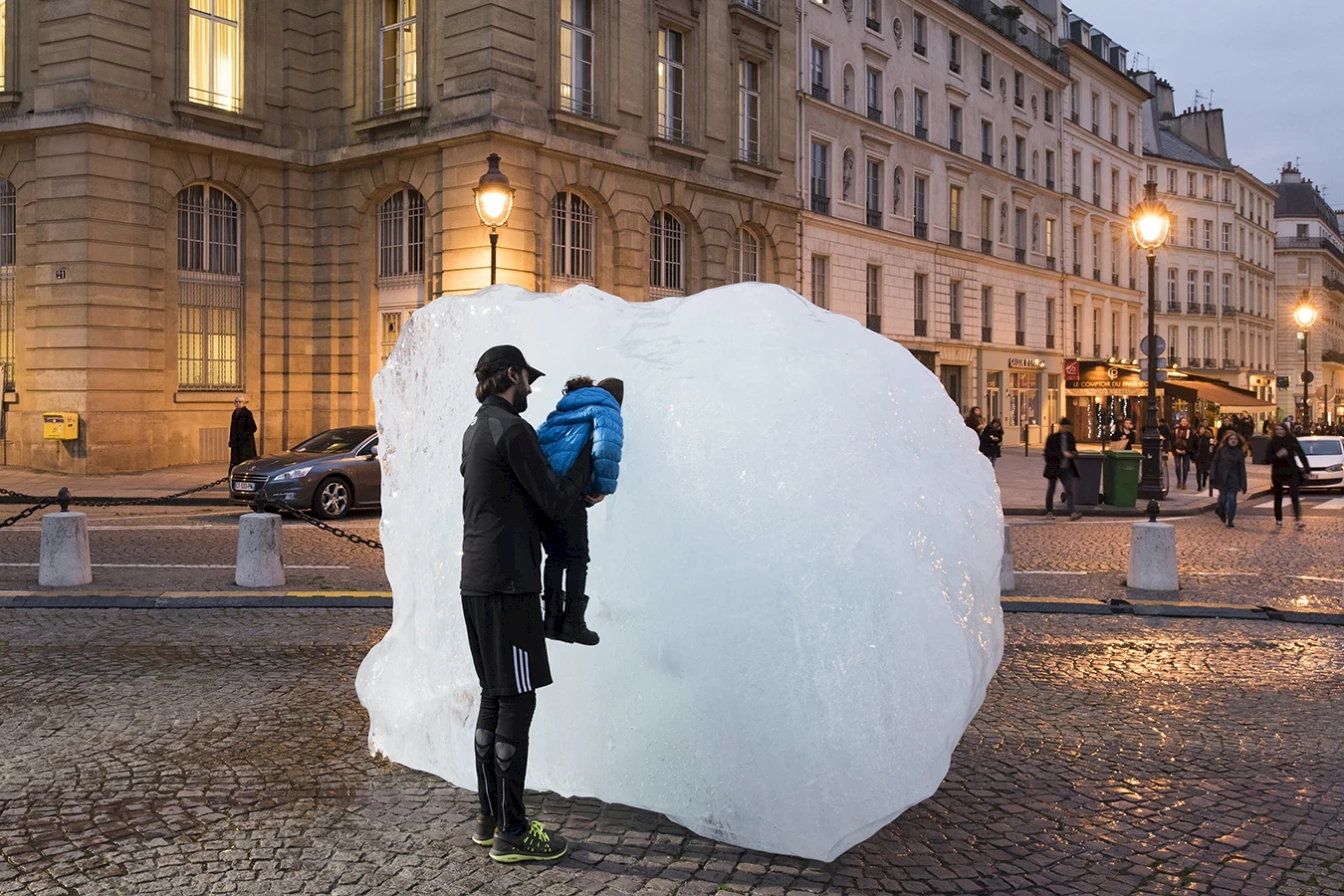Beyond COP21: Collaborating with Indigenous People to Understand Climate Change and the Arctic

Image: courtesy James Thompson.

Mel Chin, The Arctic is Paris, poster, 2015. Image: courtesy the artist.
At the COP21 meetings in Paris in December 2015, the Arctic appeared in material and elusive exhibits that ranged from icebergs shipped in from Greenland, arranged in a clock formation and set to melt slowly at the Pantheon (Eliasson & Rosing 2015; Kaljur 2015; Nechvatal 2015), to imaginations of poodle-drawn dogsleds along the River Seine (Chin 2015; Kaljur 2015–2). Like many climate-related exhibits, these works of art were meant to provoke, inspire, and warn of dire consequences both for the Arctic and, by extension, global society. In a city temporarily bloated by those deeply concerned about climate change, questions about what should be done and how in relation to climate change didn't need to be elaborated. Rather, it was enough to suggest that time is running out, and that strange things are happening in the global far North.
Arctic temperatures are indeed rising much faster than elsewhere in the world, with drastic consequences both locally and globally. As a region, the Arctic provides the most immediate view, complex as it may be, of what a warming world looks and feels like, and what it may portend. The subsequent cascading effects for the rest of the globe, in the form of melting ice and correlative sea-level rise, have acted to formulate climate change as a real and visible concept – and to re-conceptualise the Arctic as part of a deeply inter-connected global environment.
This is, by any account, a reversal compared with the historical perception of the Arctic as unknowable and impenetrable, requiring expertise and/or sacrifice in order to survey, conquer, or merely, inhabit. Many museum archives are full of artefacts that are testament to both the resourcefulness of Indigenous peoples – and those who ventured north for one reason or another to become reliant on Indigenous peoples' knowledge and guidance. Objects become a stand-in for wider bodies of traditional knowledge (Srinivasan et al 2010), and for what it means to be in relation with an Arctic environment. The challenge for museums is to connect artefacts with traditional knowledge and communities through collaborative processes, while also addressing the pressing global crisis and risk-laden futures associated with climate change and the long tail of colonialism that has produced chronic multi-faceted crises of dispossession, enclosure and violence (Callison 2014; Cruikshank 2005; Hulme 2009; Marino 2015).
Attending to a future with climate change is deeply embedded with ethical and moral contours such as how the past should be encountered, and how the future should be considered. It involves thinking not just about what we should do, but how we got here. Labeling the Arctic as metonymic of a crisis is a "distinction that produces meaning", bringing some things into focus and not others – "permitting and enabling certain narrations and giving rise to certain questions, but not others" (Roitman 2013, p. 5).
Understanding what climate change means – and this is not particular to the Arctic, but perhaps most poignant there – turns on narratives of what exactly is in crisis. Alternative visions of future histories depend as much on evidence and predictions as they do on epistemologies, meaningful collaboration, articulations of what matters and why, and notions of what constitutes change and crisis (Fischer 2003; Fortun 2009; Vigh 2008). How then to devise narrative constructs and exhibits that link existing and chronic conditions to climate change?
Narrating climate change and crisis in the Arctic
Because of its long history as an 'other', the Arctic challenges notions of what it means to witness, visualise, and narrate a crisis underway. The oft portrayed images of frozen tundra or polar bears starkly demonstrate it to be an empty space – remote, unknowable, and far away from the daily matters of everyday life for the majority of global publics who might attend an exhibition. Such representations are more likely to produce something like the popular tweet of COP21 that showed a classic picture of a polar bear on an ice floe with the text, "Welcome to the Arctic. Population: 0", utterly misrepresenting the almost four million people who live across the Arctic (Mothe 2015; YouTube 2015, Arctic Council 2015).

Image: Twitter.
Herein lies the stark challenge to represent the Arctic as a region that is full of a wide variety of living beings, including humans who have lived in relationship with ice, cold, and polar bears for thousands of years. Part of the challenge harkens to colonialism's long tail and a frontier myth, but a question also lingers elsewhere. How to situate or understand the narrative of a crisis of the environment in relation with — or even in opposition to — a crisis of people set within a longer historical context of oppression, dispossession, and environmental change? As current Inuit Circumpolar Council (ICC) Chair Okalik Eegeesiak told an Arctic reporter:
Polar bears aren't the spokespeople for climate change in the Arctic, it's the Peoples of the Arctic... So stop using polar bears and seals as the emotional icon and use Inuit as fact-based traditional knowledge holders (Quinn 2015).
How we narrate the climate crisis in the Arctic context challenges the categories and articulations that we have for vulnerability and harm. Even whilst communities set environmental change within a chronopolitical framework (Vigh 2008), where archives must be contended with (Simpson 2014) as well a politics of recognition (Coulthard 2014), dominant frames for understanding and inspiring action on climate change retain the view of: How big is the crisis and what do we do now?
Shifting understanding thus requires some excavation, of how it is that these layers of crisis operate to produce specific articulations and narratives, and determine the stakes for collaborating on and structuring narratives around climate change as a finding of both traditional and scientific knowledge, and as a communal experience.
Greenland's former ICC Chair Aqqaluuk Lynge expressed this challenge of articulation, epistemology, and collaboration in the face of colonialism and its institutions at the 2008 opening of an exhibit at Dartmouth's Hood Museum where some of Dartmouth's massive collection from explorer and scholar, Vilhjalmur Stefansson was on display (Stuckenberger 2008). The exhibit was mounted in part because of the large international gathering of scientists and policymakers who came to Dartmouth for Arctic Science Summit Week that same year. Lynge ended his speech with this charge:
With all the flurry of scientific inquiry on this issue, one could easily be led to believe that it is the researchers who are most affected by the world's changing climate and not the Inuit. I plead with western scientists to be careful how you conduct your research on our land and on our thinning ice. Work with us as equal partners and not as the colonisers and missionaries did. Help us deal with not only your own interesting research but with our concerns. For example, help us deal with industry, which is keen to see an Arctic sea route open up to them. (Stuckenberger, 2008).
Lynge situates changing climates within chronic crises, where the moral and ethical spectre looms large and produces questions about the nature and structure of working together. Scientific research becomes a potential site for exploitation or transformative collaboration via shared goals. Knowledge too is at stake – equal partnership means recognising the value and persistence of traditional knowledge, of other ways of seeing and knowing the environment and the place of communities within an environment. Economic development depends on both knowledge and power, where the stakes for governance become much higher, given the risks and benefits related to resource extraction.

Olafur Eliasson, Ice Watch, 2014. 12 ice blocks. Place du Panthéon, Paris, 2015. Photo: Martin Argyroglo. © Olafur Eliasson.
Crisis is thus judged comparatively against what could have been, what should have been, what is, and what might be. It acts both to demand transformation, and to frame what have been the ranges of normal experience. Yet, what's been normal under colonialism has been left unaddressed – climate change thus, as the latest geopolitical entry in crisis events, becomes embroiled not only in the past, but in a future that calls for self-determination and meaningful collaboration (See also Watt-Cloutier 2015).
The challenge in all spheres, museums included, is to move beyond indigenous peoples as topics and engage them as partners. Understanding the Arctic as an exemplar of climate change means recognizing the ways that indigenous people connect observations of land, ice, and sea to language, memory, history, communal experiences, moral explanations, and cultural traditions. While texture, form, and vernaculars make TK a differently constituted process of knowledge production and expertise, many community experts are also able to work with scientific data and findings (Callison, 2014). The Arctic Climate Impact Assessment (2004) remains a significant and internationally known collaboration in this respect – where epistemological differences were transformed into a document representing jointly held and integrated expertise. Yet, even with this example, the Arctic and indigenous peoples still don't have the kind of prominence in climate change policies that might be expected.
When COP21 ended in the much lauded Paris Agreement that contained no mention of the Arctic, ICC Chair Eegeesiak didn't join the celebration. Instead, she took to Twitter in response, retweeting and responding to prominent news reporters saying: "Countries failed!" She explained her position this way: "(The agreement) was historic, yes... (But) Inuit and Saami peoples wanted to have more recognition and respect for Arctic peoples... There is some mention of indigenous peoples and our rights and our role in climate change (issues) but there isn't much commitment to work with us (Quinn 2015)." It's this challenge of collaboration on shared concerns that perhaps pulls the crisis framework into fuller analytical view. It isn't that there is no crisis or that crises are somehow fabricated. Rather, discussions about what kinds of questions are allowed to be asked, what and whose knowledge matters, whose experiences are relevant, whose futures are at stake and how we know, who gets a seat at the table, and who directly suffers from decisions made are often foreclosed upon. The point is not to dismiss crisis as a label or only to call attention to it, but to open climate change up for collaborative understanding as well as problem definition and solution.
Moving towards understanding even whilst acknowledging epistemological difference and historical injustice is the gauntlet set for museums as they seek to educate and inspire diverse publics. Contending with archives and critiquing hierarchies of knowledge opens up new possibilities both for collaboration with indigenous peoples and for engaging meaningfully with TK such that a future with climate change might be seen as a crisis with a historical context and direct, ongoing impacts.
References:
Arctic Council, 2015. Arctic Peoples. Arctic Council.
Callison, C., 2014. How Climate Change Comes to Matter: The Communal Life of Facts. Duke University Press.
Chin, M., 2015. "L'arctique est Paris 2015". ArtCOP21.
Coulthard, G., 2014. Red skin, White masks. Rejecting the Colonial Politics of Recognition. Minneapolis: University of Minnesota Press.
Cruikshank, J., 2005. Do Glaciers Listen? Local Knowledge, Colonial Encounters, and Social Imagination. Vancouver and Seattle: UBC Press and University of Washington Press.
Eliasson, O. & Rosing, M., Ice Watch.
Fischer, M.M., 2003. Emergent Forms of Life and the Anthropological Voice. Duke University Press.
Fortun, K., 2009. Advocacy after Bhopal: Environmentalism, Disaster, New Global Orders. University of Chicago Press.
Hulme, M., 2009. Why We Disagree about Climate Change: Understanding Controversy, Inaction and Opportunity. Cambridge University Press.
Kaljur, L., 2015. "Ice Watch at COP 21". Arctic Journalism.
Kaljur, L., 2015. "Bringing the Arctic to Paris". Arctic Journalism.
Marino, E., 2015. Fierce Climate, Sacred Ground: An Ethnography of Climate Change in Shishmaref, Alaska. University of Alaska Press.
Mothe, P., 2015. "How media covered COP 21 and the Arctic". Arctic Journalism.
Nechvatel, J., 2015. "Olafur Eliasson's Sundial of Melting Icebergs Clocks In at Half-Past Wasteful". Hyperallergic.
Roitman, J., 2013. Anti-crisis. Duke University Press.
Simpson, A., 2014. Mohawk Interruptus: Political Life across the Borders of Settler States. Duke University Press.
Srinivasan, R., Becvar, K., Boast, R., & Enote, J., 2010. "Diverse Knowledges and Contact Zones within the Digital Museum". Science, Technology & Human Values.
Stuckenberger, A.N. ed., 2007. Thin Ice: Inuit Traditions within a Changing Environment. Hood Museum of Art.
Quinn, E., 2015. "Arctic Missing from Paris Climate Agreement". Eye on the Arctic.
Vigh, H., 2008. "Crisis and Chronicity: Anthropological Perspectives on Continuous Conflict and Decline". Ethnos, 73(1), pp.5–24.
Watt-Cloutier, S., 2015. The Right to Be Cold: One Woman's Story of Protecting Her Culture, the Arctic and the Whole Planet. Penguin Canada.